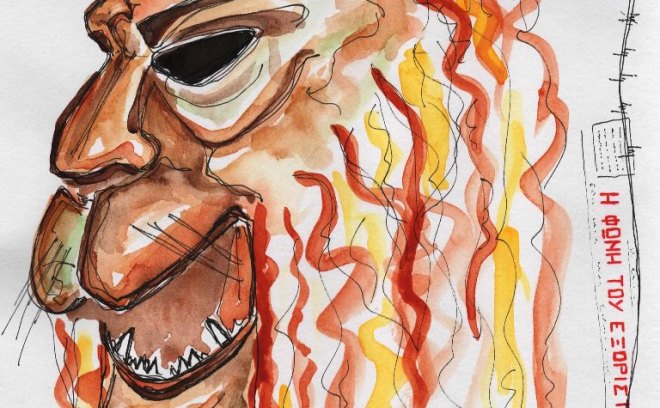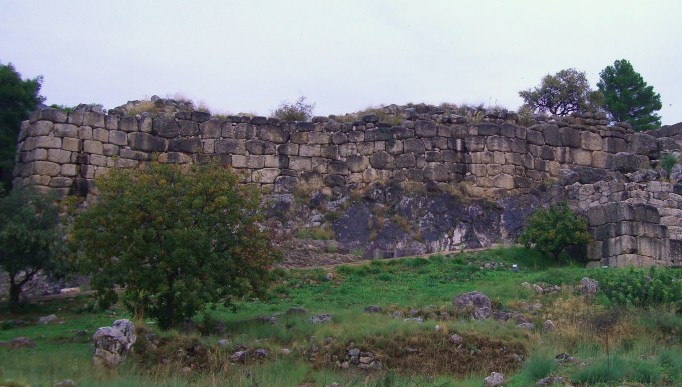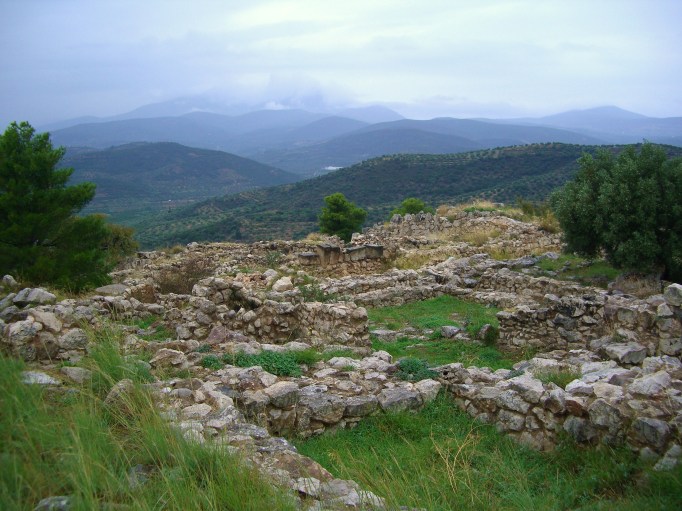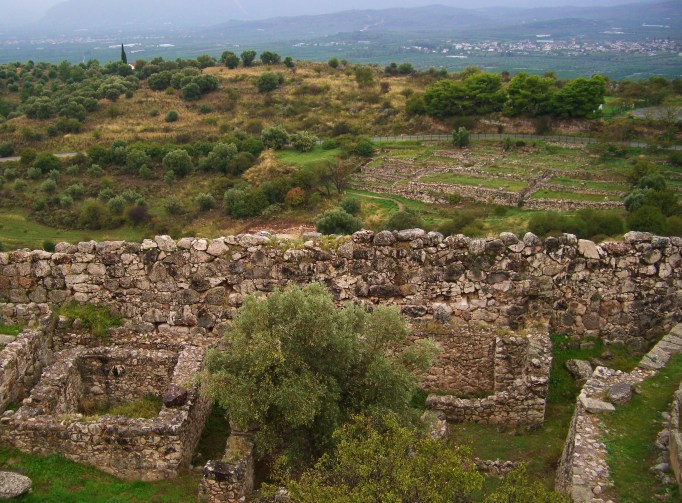: Uncategorized
From Acropolis Museum to Eridanos river: a heritage walk in Athens
Woke up to a surprisingly warm day in late winter, taking abnormally uncrowded public transport from Elefsina to Acropolis station, which was perfect to pass the time with an engaging book. I caught up with the Museum Management class inside the Acropolis museum, stepping in on Dr Nota Pantzou’s description on finding hidden clues about how artefacts and statues were used, and what their imperfections could tell us about the people that handled them. We were taken through the museum investigating management responses to modern times, such as a new display of tools for marble carving, or recently exhibited replicas of ancient statues showing original colours.
The next museum to see was the Athens University History Museum, which was reachable from the Acropolis Museum over a sloped, narrow road, and a great surrounding view of the Acropolis and Lykavittos Hill. The museum contained registries, paintings, monuments and laboratory equipment of the first university in Athens. The museum’s life is heightened by the organisation of educational programmes and cultural events performed within the museum’s unique courtyards.
After a downhill walk past the Roman Agora, passing street musicians and merchants, through to Thissio – where one can spot the Temple of Hephaestus sitting majestically within the Ancient Agora – the Public Archaeology tour had just begun. Our lecturer Dr Stelios Lekakis walked us to the starting point of our journey up the Eridanos river, seen at the centre of the Kerameikos archaeological site. A narrative of public occupation throughout ancient to modern times was told, as we walked past Roman attempts at river and road engineering, modern day flood management (would have preferred the Roman attempts), and 19th-20th century architecture such as the Eclectic and Neo-Classical style, seamlessly infused within contemporary buildings. Our bodies were walking on modern streets, but our minds were centred on the millennia of stratified urban construction hiding away a once majestic river, with only the occasional olive tree pointing us in the right direction. We also arrived just in time to witness the disciplined “Changing of the Guards” in front of Parliament in Syntagma square.

Steep view of road from the base Lykavittos towards Kolonaki, showing the river flow direction of the ancient Eridanos.
After an uphill stroll past Syntagma and Kolonaki, passing many archaeological sites oblivious to the public eye, we finally reached the exact location of the old spring that used to heavily feed the Eridanos river. Unfortunately it has now been built over by a pompous building, inside of which holds a fountain. From an urban perspective however, the natural topography that nurtured Athens’ ancient rivers could still be recognised from downhill views between city structures. So it was a bittersweet ending to the tour, teaching us how to investigate the past through a microscope on public space. We took a much deserved and very relaxing coffee at a lovely cafe nearby, reliving the day’s events and having a laugh or two.
Photos by Alex Costas
 Michael Williams, BA in Ancient History, GDip in Maritime Archaeology. Particularly interested in Maritime Heritage of the ancient Mediterranean. I have worked in Indigenous Aboriginal sites around New South Wales and in underwater sites in Port Macdonnell. Experience with archaeological drawing.
Michael Williams, BA in Ancient History, GDip in Maritime Archaeology. Particularly interested in Maritime Heritage of the ancient Mediterranean. I have worked in Indigenous Aboriginal sites around New South Wales and in underwater sites in Port Macdonnell. Experience with archaeological drawing.
Art in Exile: visit to the Museum of Political Exiles "Ai Stratis"
The museum is small, and if you pass by too quickly you will miss it. From the outside you wouldn’t know what an extraordinary part of humanity and human history is kept inside, all for our—the public’s— sake.
There seems to be one thing above all others that human beings give readily to one another, freely and without reserve, and usually without regret — cruelty. All the world’s histories are riddled with it and the twentieth century saw some of the best of the stuff we could muster. Greece is no exception, although her recent dark history is often overlooked.

Sketch of a displayed lion mask created by the exiled artist Katerina Hariati-Sismani, used in a theatrical production on the island by and for the exiles. The text (“Η ΦΟΝΗ ΤΟΥ ΕΧΟΡΙΣΤΟΥ”- “The Voice of the Exile”) is from the exiles’ self-published newspaper, and the barbed-wire is fashioned after a detail from an exile’s wood-block print.
The Museum of Political Exiles “Ai Stratis” has documented, archived, and displayed tangible and intangible memories of just such cruelty which occurred in Greece from the 1920s through to the late 1960s: the exile of “dangerous” individuals in the remotest islands of the country. The extraordinary thing about the Ai Stratis museum is that the Greeks who were internally exiled consciously documented their lives and works on the island with the intention of later creating a place to exhibit their experience. What they were unable to do their descendants took up and completed, and created a place for the public to learn and remember.
The island of Ai Stratis was home to a local population which cohabitated with thousands of political exiles imprisoned there over a span of forty-plus years. The exhibition includes the material remains of the exiles’ life on the island, from a mock-up of a typical male bedroom-hut to artifacts from daily life. What made the biggest impression, touched me the deepest, was that the exhibition isn’t one of photo-documentation, walls of pictures of people emaciated and dying, but one of beautiful art. There is darkness reflected in that art, yes, but there is tenderness, and happiness, joy, entertainment, and hope too. The nature of political exile usually includes a nation’s intelligentsia, artists, writers and poets and Ai Stratis was no exception. That these people continued to live and practice their art, the highest level of humanity, in the face of the lowest level, is what impresses. What’s more is that other exiles who did not already possess a talent for art used their time and the scant resources on the island to learn and to create; the results, as we see displayed in the museum, are some of the most wonderful sculptures, paintings, engravings, prints, poetry and even theatrical masks created in this part of the world in the twentieth century.
The Museum of Political Exiles “Ai Stratis” is a place for the public to witness and interact with the remains of memories, both good and bad, of Greek exiles who transcended their dark circumstance and cruelty. The experience of that museum, and having class conducted in it, was brilliant.
Photos and sketch by Alex Costas.
 Alexandros Costas has a BA (Hons) in Comparative Religious Studies (San Jose State University) and is now a student of the MA in Heritage Management. He worked in study abroad in Greece for over ten years, and through that experience observed the interactions of foreign students with Greek heritage, inspiring him to learn more about heritage and the public.
Alexandros Costas has a BA (Hons) in Comparative Religious Studies (San Jose State University) and is now a student of the MA in Heritage Management. He worked in study abroad in Greece for over ten years, and through that experience observed the interactions of foreign students with Greek heritage, inspiring him to learn more about heritage and the public.
Integrating heritage into education: Namibia case study
The future of Namibian heritage lies in the hands of learners and students in schools, colleges and universities.
When Namibia gained its independence from South Africa’s apartheid regime in 1990, it inherited an extremely biased educational system, the “Bantu Education”, which used Afrikaans and English as teaching languages, made no reference to Namibian heritage, and only limited mention of Namibian history. Unfortunately, I myself was educated under this teacher-centered system that neither promoted independent thinking, nor used examples familiar to us in any of the subjects we were taught.
In 1998, just a year before the end of my high school, new learner-centered syllabi were introduced which tried to include more familiar contents, with Namibian case studies as examples. But this was probably not enough. In fact, in 2010 the Namibian Institute for Educational Development (NIED, the national centre for curriculum development), asked the Museum Association of Namibia to carry out research in order to assess how well heritage was integrated in school syllabi and tertiary education, and to propose recommendations that could be applied during the coming syllabi review. I had the chance to be part of the team tasked with doing this research, and I was thrilled to give my contribution.
We started with an analysis of school syllabi and universities course outlines. Subjects ranged from Science and Geography to History, Arts & Design, and Religion. For the tertiary level we considered departments including Visual and Performing Arts, Biology, Tourism, and Language. The study clearly showed that most subjects lacked any correlation to our past and present heritage. Therefore, we made suggestions to include heritage-related examples not only in the Humanities, but also in the area of Science. For instance, in Physics, to explain the notion of “friction” in Grade 8, we proposed to introduce as an example the traditional ways the San community used to obtain fire by rubbing sticks.
As for the methodology, we suggested to encourage site visits and school competitions, such as the School Clubs and Museums Exhibition (SCAMX), an annual event dedicated to young people engagement in museum and heritage development, aiming at making Namibian museums more inclusive and education-oriented. We also proposed to establish synergies between curriculum developers, heritage institutions and local communities, so as to include local traditional knowledge in the syllabi for the new generations.
Overall, our aim was to incorporate in Namibian education the value of our environment and our cultural heritage so as to allow young people to learn about their own history and heritage and thus form their identity. The desk and field research were the most interesting parts for me because I had the chance to discuss with curriculum developers and heads of departments, and understand through hands-on experience the real significance of heritage and its role in society. This was a good start for Namibia, I am looking forward to seeing the revised syllabi!
Photos by the Museum Association of Namibia
 Helvi Inotila Elago has a Bachelor in Education (Economics and Business Studies), a PGD (hons.) in Museum and Heritage Studies, and is currently a student of the MA in Heritage Management. She has worked in heritage for 5 years and she would like to focus on the preservation of heritage through education and public engagement.
Helvi Inotila Elago has a Bachelor in Education (Economics and Business Studies), a PGD (hons.) in Museum and Heritage Studies, and is currently a student of the MA in Heritage Management. She has worked in heritage for 5 years and she would like to focus on the preservation of heritage through education and public engagement.
Mount Athos: a timeless place
Chilly December winds hit the face as I embark on the first 8:45 am ferry to Mount Athos from the port of Ouranoupolis. Mount Athos is an enormous World Heritage Site, which is lawfully Greek, though ecclesiastically it is under the Orthodox Patriarchate of Constantinople (Istanbul). The boat journey starts with an ever-changing landscape that turns wilder and untouched. The boat makes a series of stops before reaching the final destination at the port of Dafni. On the way, there are these amazing sea-edged monasteries which have been there for over a millennium. They seem to be nothing less than the creation of a dream seller. The tall towers and the spires that perch out of wilderness harmonise with the raw untamed landscape.
After reaching Dafni, my class-mate Glenn Martin and I start our adventurous journey to the Monastery of Simonos Petra (Σίμωνος Πέτρα or Σιμωνόπετρα), which is multicultural in its composition, hosting monks from across the world. The walk to the monastery is a 6-hour trek with capturing views of the marine landscape with the sun cracking through the dark cold clouds and shining over the slate laid roofs of distant monasteries. On our way, we come across some kellis, clusters of quaint wooden and stone construction houses, which are self-sufficient micro-communities of monks.
Our destination, Simonos Petra, is an outstanding piece of architecture. This edge hugging seven storied monasteries is a perfect sojourn for me, as I have waited so long to see this sophistication of ancient architectural marvel. The guest rooms, on the mid-levels, have wooden cantilevered balconies that shoot out into the vast open sea. The construction details, long oil-lamp lit corridors, oversize gears to move the doors, the mechanical aqueducts and materials give us the illusion of being back in the medieval ages. The enchanted aura of this place is also due to the fact that many things in the monastery are still carried out in a traditional manual way.
These monasteries allow visitors to stay overnight, and during our four-day stay on Mount Athos we experience life in monks’ shoes. It is a fascinating schedule that starts with the 4:00 am service, when they venerate the treasured relics and portable icons in the dark candle lit church with shining gold-leaf interiors. This is followed by the first meal of the day at 8:00 am. The day ends with a service at 3:00 pm and the last meal of the day at 4:00 pm.
The monastery is a living organism: it sustains its monks providing all they need. We are fortunate enough to be allowed to see the book-making room – where the monks work on conserving and binding the precious manuscripts, and the stepped greens which are their source of organic and vegetarian diet. It is thought-provoking to listen to the stories of some of them who came to this island a long time ago and never left as they found their own self here. Each monk walking around in the pitch black cloak has a captivating story of how they reached this place.

A monk at work
Our journey then unfolds like a labyrinth of stories. Each monastery is a breathing storyteller, unique architecturally as well as in its functions. These monasteries are an excellent example of how a product of mind can fuse in so well with a product of nature. The uses of materials and the construction techniques, among other details, are a metaphor of these monks who are unique but simple. These monasteries teach us that we don’t need new materials: it is the idea that counts, the concept and its logical application that can lead to such brilliant long lasting examples of timeless construction.
Such an amazing lesson for professionals in our field like architects and conservators.
Photos by Siddhant Shah.
 Siddhant Shah is an Architect with Majors in Indian Aesthetics. He has worked with the State Archaeological Department (Mumbai) and has undertaken Heritage Volunteer training for UNESCO and ICOMOS. He is currently based in Greece, completing an MA in Heritage Management, and focuses on Management, Marketing and Disabled-Friendliness of Archaeological/Heritage Sites.
Siddhant Shah is an Architect with Majors in Indian Aesthetics. He has worked with the State Archaeological Department (Mumbai) and has undertaken Heritage Volunteer training for UNESCO and ICOMOS. He is currently based in Greece, completing an MA in Heritage Management, and focuses on Management, Marketing and Disabled-Friendliness of Archaeological/Heritage Sites.
Mycenae: a trip to the fortress
Basically for years I have dreamed about visiting the site of ancient Mycenae in Greece and so I may be a bit biased when it comes to describing about my experiences when I finally visited there. Actually this holds true for most ancient sites in Greece. But holding unnaturally high expectations of a site is not always a good thing as it can lead to disappointment, and I must admit I did put Mycenae on a pedestal. How could you not? This is the capital of Mycenaean civilisation, a civilisation that flourished throughout the entire Greek world from the 16th – 12th centuries BCE. It is also the kingdom of Homer’s Agamemnon, son of Atreus, king of kings.
For me it was such an eerie feeling walking up the hill toward that fortress; mixed emotions of excitement, awe and intimidation. The sheer size of the stone used in the construction of the wall is an incredible feat of engineering for the time (1350-1200 BCE), called Cyclopean Walls because it was thought that only giants could have moved such large blocks of stone.
When reaching the top of the site you really get a feel for the isolated location of the fortress surrounded by mountains in all directions. Built on the cliffs edge, Mycenae truly is an imposing fortification and a testament to the military mentality of the Mycenaean civilisation; a stronghold, which I wouldn’t say is aesthetically pleasing, rather it is the surrounding landscape that really gives Mycenae its beauty, with defence playing the pivotal role in the location choice for its construction.
It doesn’t take very long to walk around the whole site and there is pretty much one path that you follow as it loops around. It is hard to picture what the inside of the complex might have looked like in Mycenaean times, which included grave circles (which are actually dated back to the Middle Helladic period 17th – 16th c. BCE), a granary, houses, artists workshops and the palace itself at the peak. However some parts are remarkably well preserved if you consider just how old the place actually is.
There is also a tunnel (an ancient cistern) at the far end of the site which you can enter into. I’m not sure how far down it actually goes because it quickly becomes pitch black and we didn’t venture further for fear of bats or bears or the ghost of Atreus, but now I am rather curious if anyone could enlighten me.
There are many other important sites leading up to the acropolis such as the huge tholos tombs, some of which are located nearby and are well worth a visit as well.
Mycenaean architecture is such a stark contrast to the beauty and harmony of the classical Greek model of architecture that most of us envisage when we picture Greece. This just serves as one example of the variety and depth of human history that this country has to offer.
Photos by Glenn Martin.
 Glenn Martin has a BA (hons) in Ancient History and is currently a student of the MA in Heritage Management. He has strong interests in Classical Greek art, literature and architecture, and would like to focus on the conservation of heritage particularly through digital technology.
Glenn Martin has a BA (hons) in Ancient History and is currently a student of the MA in Heritage Management. He has strong interests in Classical Greek art, literature and architecture, and would like to focus on the conservation of heritage particularly through digital technology.
Esperanto, language of the world
From the HERMA student lecture series 2014-15
Language. The intangible part of any culture, ever changing, fluid and living entity. Language echoes the past, tells the present and reflects the future. It is the bridge and the tool which facilitates human contact and fosters understanding of others. It was these noble ideas, that Ludwik Lazarus Zamenhof was driven by when he created the artificial language Esperanto.
Zamenhof was born in 1859 in Bialystok, Poland (at the time Russian empire). Bialystok was a lively little town, where Jews, Poles, Belarusians, Germans and other ethnicities lived together. Zamenhof noticed quarrels arise easily between them and he was convinced language miscommunication largely contributed to this.
Thus, an idea started forming in his mind, which eventually led to creation of Esperanto. His vision was to create an international language, easy and logical, one which would help better mutual understanding and communication between people. In 1887, Zamenhof created the Unua Libro, detailing Esperanto. He, himself called it internacia lingvo (international language). The name Esperanto actually derives from the pseudonym doktoro Esperanto (Esperanto = one who hopes), under which Zamenhof wrote the first book.
The estimation is that today between 100,000 and 2,000,000 people worldwide fluently or actively speak Esperanto. Within this number there are approximately 1000 Denaskuloj or native Esperanto speakers, an interesting fact given that no country adopted Esperanto as its official language.
A question may be posed, considering Esperanto’s origin: can it be used to convey the complexity of culture and most abstract human ideas? The answer is a resounding yes. William Auld, Scottish poet, author, translator and magazine editor, wrote chiefly in Esperanto. His opus in Esperanto, particularly modernist poem La Infana Raso (The Infant Race), earned him a Nobel Prize in Literature nomination in 1999. He viewed Esperanto as
the expression of a common human culture, unencumbered by national frontiers. Thus it is considered a culture on its own (Auld 1998).
Beside Auld, notable Esperanto writers are Marjorie Boulton, Kalman Kalocsay, Nikolai Nekrasov, Claude Piron and many others. Other than creating original body of work in Esperanto, there have been many translation of the world literature into Esperanto. Auld translated Lord of the Rings by Tolkien, Sonnets by Shakespeare and Zamenhof himself translated The Old Testament.
Literature is not the only vehicle for Esperanto culture. It has been expressed through music, film, theatre plays and habits that Esperanto community shares. From pop to hip hop, Esperanto music covers it all. For a taste of it, one could tune into 24 hour Internet radio station Muzaiko. Some of notable Esperanto groups and musicians are La Perdita Generacio, JoMo, Dolcamar, Kaj Tiel Plu and Kajto.
Being it during Unversala Kongreso de Esperanto (World Congress of Esperanto) or number of other gatherings and occasions, Esperantists meet year round and socialize in their unique way. One thing that they earnestly try to avoid is to krokodili (talk crocodile, meaning to talk in languages other than Esperanto when they meet).
To dive into the world of this language and culture, one might consider a visit to two existing Esperanto museums: The Esperanto Museum of the Austrian National Library and Esperanto Museum, in Zaozhuang University in east China’s Shandong Province.
References
Auld, W. (1998). La Fenomeno Esperanto. Rotterdam: Universala Esperanto-Asocio.
Photos by Gorana Sekulic, unless otherwise stated.
 Gorana Sekulic is student in 2014-15 cohort of MA Heritage Management. She has a bachelor degree in Journalism and Communication, as well as work experience in the fields of journalism, film and gender equality. She is interested in seeing how communication and language can work together with culture and heritage to make it more visible.
Gorana Sekulic is student in 2014-15 cohort of MA Heritage Management. She has a bachelor degree in Journalism and Communication, as well as work experience in the fields of journalism, film and gender equality. She is interested in seeing how communication and language can work together with culture and heritage to make it more visible.



















